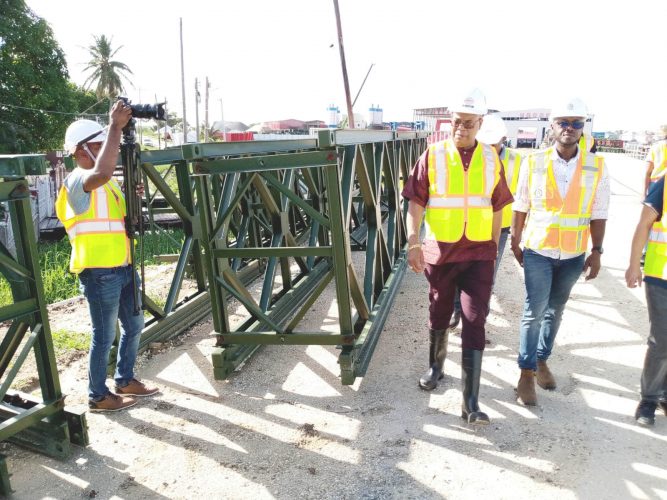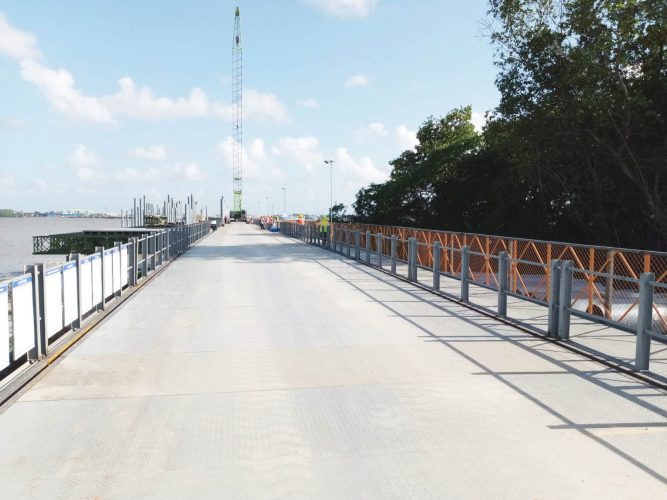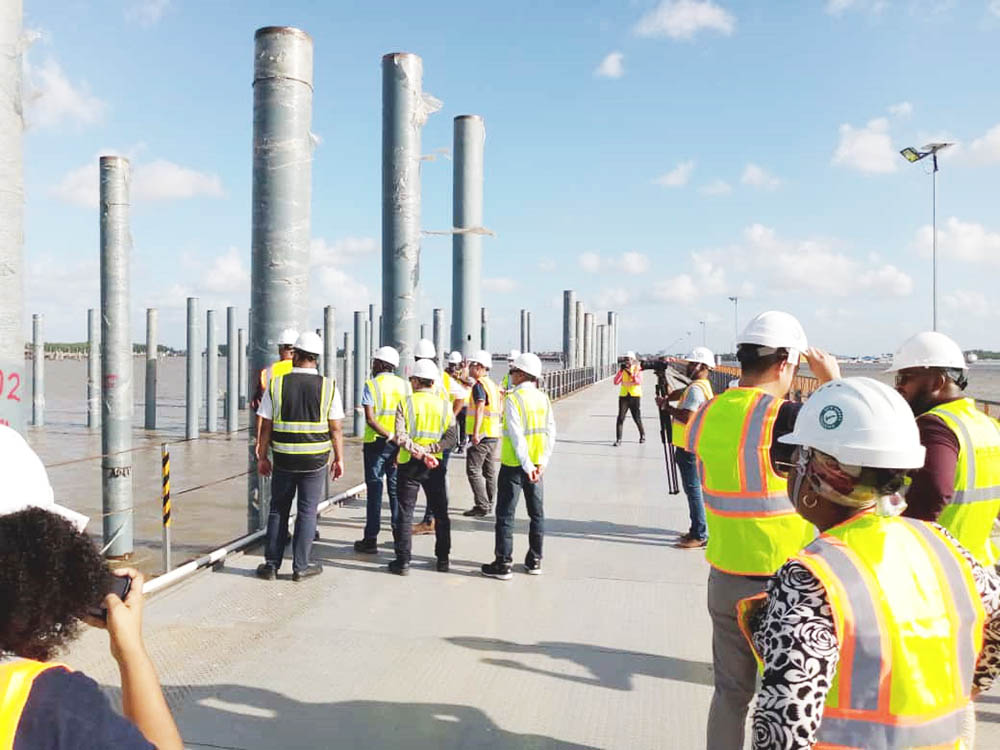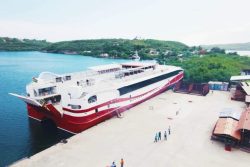By Antonio Dey
The temporary structure which will aid in the construction of the New Demerara Harbour Bridge is 100% completed, Minister of Public Works Juan Edghill disclosed yesterday.
The minister made this announcement during an inspection of the western section of the temporary structure. It will pave the way for ongoing construction of the new four-lane, high-span bridge that will connect the west and east banks of the Demerara River, which is 33% completed.
“I was invited here today by the contractor to bring me up to date as the subject minister on the milestones that we would have achieved in terms of completing the structure for this bridge. Importantly, it is time-bound, which means that we have to meet a significant deadline and that works are progressing smoothly,” he informed.

“Based on my inspection and the reports I have received today from the contractor, 100% of the temporary structure is completed, which I am happy for. And they are now putting in the platforms, which are required…”
The Public Works Minister detailed that the main tower, which reporters were standing on yesterday, will link the 300-metre span from the western side to the eastern side of the bridge. He said that each of the towers will be supported by 38 steel piles. Further, each of the steel piles will accumulate approximately 500 cubic metres of concrete.
“From the technical explanation in layman’s terms, this is about 58 trucks of concrete the contractors will be using. Note these are ready-mix trucks, and from what the contractor is telling me, one of those piles and the concrete that is used is sufficient to build a three-storey house in Guyana…,” he elaborated.
Edghill said that the landmark pouring of concrete that was estimated for December 5th, 2022 saw the pouring of concrete on the eastern side where eight of those piles were completed. He said that the benchmark time for starting the pouring of concrete on the 38 piles was January 6 (tomorrow).

“My invitation was to come on the 5th of January to see everything before we start on the 6th, but as you all know and you would hear publicly we are going to be in Linden tomorrow with His Excellency President Irfaan Ali for the signing of the New Wismar-Mackenzie bridge,” he said.n “So, another landmark is being met which would be the pouring of concrete to accommodate the 38 piles that will form the platform for the two high spans.”
Edghill said that when he visited the bridge recently there were concerns about the shipping of materials through the Panama Canal which is faced with low water levels as a result of the prolonged El Nino season.
“When the contractors related this to me, our clear instructions were to let us find ways and means of working around the solution and the company [China Railway Construction (Caribbean) Company Limited (CRCCCL)] informed me that they are using a longer route through Cape Verde which was more reliable at the time,” he related. “So, most of the materials which were delayed are already in place.”
He told reporters that the bridge was being constructed in compliance with international engineering standards. Project Engineer Patrick Thompson, alongside another employee at the Ministry of Public Works and a consultant from Polytechnica, travelled to China back around November/December for two weeks to inspect all facilities where the materials are being fabricated before shipment, he said.
Edghill added that due to the magnitude and scope of the work being undertaken, it was important for the contracted company to have sufficient materials. He said Polytechnica is the consultancy firm that is overlooking the infrastructural development to ensure excellence.
Despite the significant delays, he said, the contracted company was able to bounce back on its feet and get things running as it is now working night and day.
He also addressed the subject of the company’s employees following stringent measures relating to occupational health and safety. According to him, so far, the company is abiding by these rules as safety is paramount.
“They have been given all the clear guidance and safety measures that are required to ensure transit is safe… The work of the contractor is not hindered and that no one is injured while transiting,” he said. “The contractor now has in place his platform so he could move in and out and expeditiously get this contract sorted out.”
Thompson added that the ministry has been ensuring that the workers practise good occupational, health and safety, while the contracted company is working 24 hours and 7 days per week on the bridge project.
As part of the contractual agreement, the minister was assured the project would be completed by the end of 2024.
CRCCCL has been working around the clock to make up for lost time and to stay ahead of schedule. Two new drilling machines were seen on site complementing the existing ones to accelerate drilling and preparatory pile works.
The 2.6-kilometre crossing, being built by China Railway Construction Corporation (International) Ltd in a joint venture with China Railway Construction (Caribbean) Company Ltd and China Railway Construction Bridge Engineering Bureau Group Company Ltd, will link Nandy Park on the East Bank Demerara with La Grange on the West Bank Demerara. It will have four lanes, with a total width of 23.6 metres that include the median and the shoulders, providing sufficient room for safe and effective traffic flow.
Meanwhile, of the 371 people employed to work on the project, 180 are Chinese, 98 Guyanese, 85 Venezuelans, 1 Cuban, 5 Trinidadians and 2 Nigerians. Notably 90 of the 371 are indirect and 281 are direct labour.







